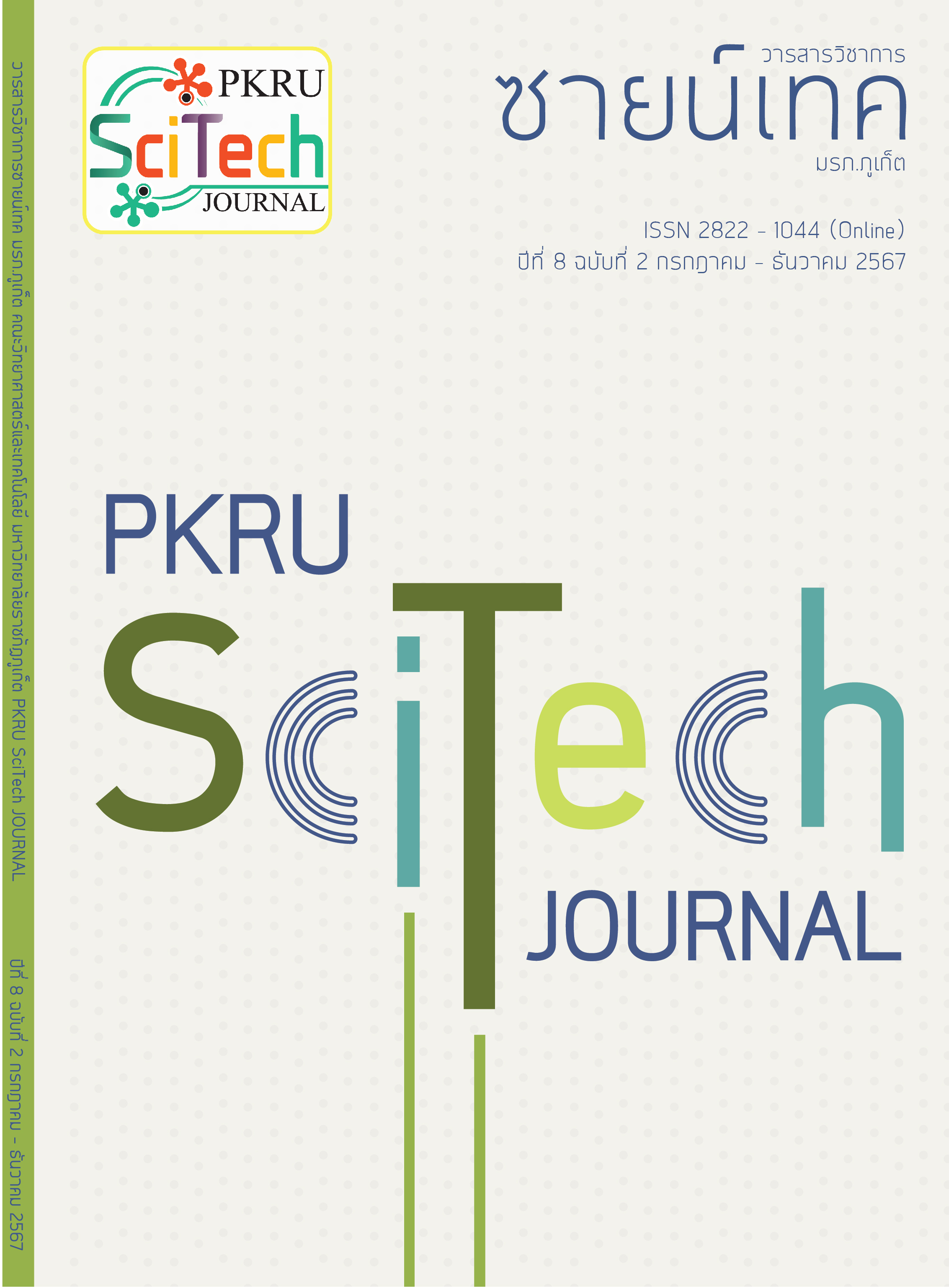Development of a Simple DTT Assay for Determining the Oxidative Potential of PM2.5 Samples
Main Article Content
Abstract
The research aimed to determine the optimal conditions for a simplified dithiothreitol (DTT) assay using a microplate reader to assess the oxidative potential of PM2.5 samples. The method is based on measuring the rate of DTT consumption as it reacts with reactive oxygen species (ROS) present in the particulate matter over different time intervals. The remaining DTT is quantified by its absorbance after reacting with 5,5'-dithio-bis-[2-nitrobenzoic acid] (DTNB). The optimal conditions were as follows: PM2.5 samples, collected on quartz fiber filters (amount less than 0.5 mg), were extracted with 4 mL of phosphate buffer solution using a shaker at room temperature for 30 minutes. Subsequently, 100 µL of the extracted solution was aliquoted to react with 50 µL of 0.10 mM DTT solution at time intervals of 0, 5, 10, 15, 20, 25, and 30 minutes, respectively. Then, 100 µL of 0.40 mM DTNB was added, and the absorbance was measured at lmax 410 nm. The slope and intercept of the absorbance decline with reaction time were used to calculate the oxidative potential (OP). Twelve PM2.5 samples collected during the daytime in March–April 2022 in Chiang Mai Province (57.8 ± 14.4 µg/m³) were tested. The average oxidative potential of the particulate matter, calculated relative to air volume (OPv) and particulate mass (OPm), was 0.304 ± 0.133 nmol/min·m³ and 5.05 ± 1.65 pmol/min·µg, respectively, indicating low oxidative toxicity of the substances in the dust samples.
Article Details

This work is licensed under a Creative Commons Attribution-NonCommercial-NoDerivatives 4.0 International License.
- The original content that appears in this journal is the responsibility of the author excluding any typographical errors.
- The copyright of manuscripts that published in PKRU SciTech Journal is owned by PKRU SciTech Journal.
References
เกวลิิน อินลวง และ ชาคริต โชติอมรศักดิ์. (2565). ความสัมพันธ์ของจุดความร้อนในพื้นที่ภาคเหนือตอนบนของประเทศไทยและพื้นที่โดยรอบต่อค่าความเข้มข้น PM2.5 : กรณีศึกษาช่วงฤดูหมอกควัน พ.ศ.2562. วารสารวิชาการพระจอมเกล้าพระนครเหนือ, 33(2), 588–600.
Kraisitnitikul, P., Thepnuan, D., Chansuebsri, S., Yabueng, N., & Wiriya, W. (2024). Contrasting compositions of PM2.5 in Northern Thailand during La Niña (2017) and El Niño (2019). Journal of Environmental Sciences, 135, 585–599.
Thepnuan, D., Chantara, S., Lee, C. Te, Lin, N. H., & Tsai, Y. I. (2019). Molecular markers for biomass burning associated with the characterization of PM2.5 and component sources during dry season haze episodes in Upper South East Asia. Science of the Total Environment, 658, 708–722.
Thepnuan, D., & Chantara, S. (2020). Characterization of PM2.5-bound polycyclic aromatic hydrocarbons in Chiang Mai, Thailand during biomass open burning period of 2016. Applied Environmental Research, 42(3), 11–24.
Borlaza, L. J. S., Cosep, E. M. R., Kim, S., Lee, K., Joo, H., Park, M., Bate, D., Cayetano, M. G., & Park, K. (2018). Oxidative potential of fine ambient particles in various environments. Environmental Pollution, 243, 1–26.
Jiang, H., Ahmed, C. M. S., Canchola, A., Chen, J. Y., & Lin, Y. H. (2019). Use of dithiothreitol assay to evaluate the oxidative potential of atmospheric aerosols. Atmosphere, 10(10), 571, 1–21.
Liu, W. J., Xu, Y. S., Liu, W. X., Liu, Q. Y., Yu, S. Y., Liu, Y., Wang, X., & Tao, S. (2018). Oxidative potential of ambient PM2.5 in the coastal cities of the Bohai Sea, northern China: seasonal variation and source apportionment. Environmental Pollution, 236, 514–528.
Wang, J., Lin, X., Lu, L., Wu, Y., Zhang, H., Lv, Q., Liu, W., Zhang, Y., & Zhuang, S. (2019). Temporal variation of oxidative potential of water-soluble components of ambient PM2.5 measured by dithiothreitol (DTT) assay. Science of The Total Environment, 649, 969–978.
Hsiao, T. C., Chou, L. T., Pan, S. Y., Young, L. H., Chi, K. H., Chen, A. Y. (2021). Chemically and temporally resolved oxidative potential of urban fine particulate matter. Environmental Pollution, 291, 118206.
Mettakoonpitak, J., Sawatdichai, N., Thepnuan, D., Siripinyanond, A., Henry, C. S., & Chantara, S. (2023). Microfluidic paper-based analytical devices for simultaneous detection of oxidative potential and copper in aerosol samples. Microchimica Acta, 190(6), 241.
Sameenoi, Y., Panymeesamer, P., Supalakorn, N., Koehler, K., Chailapakul, O., Henry, C. S., & Volckens, J. (2012). A Microfluidic Paper-based Analytical Device (µPAD) for Aerosol Oxidative Activity. Environmental Science and Technology, 47(2), 932–940.


